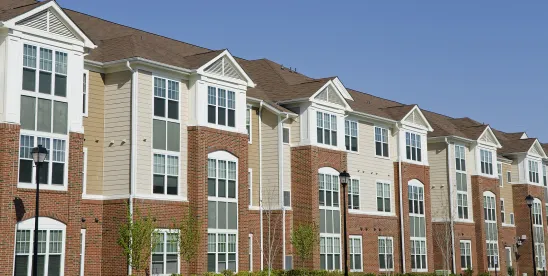SB 684 and SB 1123 (Caballero) expand the Starter Home Revitalization Act to further facilitate the construction of “starter” home projects consisting of up to 10 dwelling units (not exceeding an average of 1,750 net habitable square feet) on up to 10 parcels. SB 684 provides for a streamlined ministerial (i.e., no CEQA) approval process for qualifying housing development projects in multifamily zoning districts, effective January 1, 2024. SB 1123 extends the same streamlined ministerial approval process to qualifying housing development projects on vacant lots in single-family zoning districts, effective July 1, 2025.
STREAMLINED MINISTERIAL APPROVAL PROCESS
The Starter Home Revitalization Act requires ministerial and expedited approval of qualifying housing development projects. The Act provides:
- The local agency must ministerially consider an application for a qualifying housing development project, including the parcel map or tentative and final map, without discretionary review or a hearing. This means that the project will not be subject to environmental review under CEQA or administrative appeal.
- The local agency must approve or deny an application for a qualifying housing development project and the associated parcel map or a tentative map within 60 days of receipt of a “completed” application. If it makes no decision within that time limit, the project will be deemed approved as a matter of law.
- The local agency may only disapprove a qualifying housing development project, including the parcel map or tentative and final map, if it makes a written finding, based on the preponderance of the evidence, that the project would have a specific adverse impact, as defined in Gov. Code § 65589.5(d)(2), upon the public health and safety for which there is no feasible method to satisfactorily mitigate or avoid the specific adverse, impact. This creates a high threshold for the local agency.
- Except as specified below (minimum parcel square footage), the local agency cannot impose minimum requirements on the size, width, depth, or dimensions of an individual parcel created by a qualifying housing development project. As of July 1, 2025 (the effective date of SB 1123), the local agency also cannot impose minimum parcel frontage requirements.
- The proposed subdivision must conform to all applicable objective requirements of the Subdivision Map Act. The local agency may also impose local objective zoning, subdivision and design standards during the project approval process but cannot: (i) require setbacks between the units, except as required under the California Building Code; (ii) require side and rear setbacks greater than four feet from the original lot line (no setback shall be required for an existing structure or replacement structure in the same location, as specified); (iii) impose a FAR limit of less than 1.25 (for projects with 8-10 units) or less than 1.0 (for projects with 3 to 7 units); (iv) impose certain parking requirements (as specified); or (v) impose requirements that only apply to Starter Home Revitalization Act projects.
- The imposition of local objective zoning, subdivision and design standards also cannot physically preclude the development of a qualifying housing development project built to the densities specified in Gov. Code § 65583.2(c)(3)(B) (e.g., at least 30 dwelling units per acre for a jurisdiction in a metropolitan county and at least 20 dwelling units per acre for a suburban jurisdiction). There is one exception to this rule, which pertains to the maximum building height for qualifying housing development projects in single-family zoning districts (see below). This provision should make it more challenging for local agencies to impose local standards.
- The local agency must approve the building permit for an approved housing development project before the final subdivision map has been recorded, meaning that construction can begin even though the official subdivision process is not yet fully complete. However, a certificate of occupancy will not be issued until the final map is recorded.
- Assembly Bill (AB) 2234 separately requires local agencies to process post-entitlement phase permit applications, including but not limited to building permit applications, for housing development projects within specified timeframes. The local agency must determine whether an application for a post-entitlement phase permit application is complete within 15 days of receiving the application. For housing development projects with 25 or fewer units, the local agency must complete its review within 30 business days after the application is deemed complete and either: (i) provide a full set of comments with a comprehensive request for revisions; or (ii) approve the permit application within that timeframe (subject to specified exceptions).
- AB 2234 provides that any failure to meet the foregoing deadlines is a violation of the Housing Accountability Act (Gov. Code § 65589.5) (HAA).
- The local agency may condition issuance of the building permit on the project applicant fulfilling certain requirements, such as a guarantee that a final map will be recorded or the provision of security for the fulfillment of conditions of approval and construction of any necessary infrastructure improvements.
QUALIFYING PROJECTS: THRESHOLD REQUIREMENTS
The following threshold requirements must be met for a housing development project to qualify for streamlined ministerial approval under the Starter Home Revitalization Act. Additional requirements vary depending on whether the project is proposed in a multifamily zoning district or a single-family zoning district (see below).
- The project cannot propose more than 10 dwelling units on more than 10 lots. As of July 1, 2025 (the effective date of SB 1123), the local agency may choose (but is not required) to also permit accessory dwelling units or junior accessory dwelling units, which would not count toward the 10-unit maximum. See also Senate Bill (SB) 1211 (Skinner), which expands opportunities for building ADUs.
- Minimum density requirements must be met:
- If the lot proposed to be subdivided is identified in the local jurisdiction’s legally compliant housing element, the project must result in at least as many dwelling units projected for the parcel in the housing element and must include any low- or very low-income housing units assumed for the parcel to meet the local jurisdiction’s regional housing needs allocation (RHNA), as specified in the housing element. This is consistent with the “no net loss” rule under state law.
- If the lot proposed to be subdivided is not identified in the housing element, or the housing element is non-compliant, the project must result in at least as many dwelling units as the maximum allowable residential density under local zoning. As of July 1, 2025 (the effective date of SB 1123), under this scenario, the project must result in the greater of: (i) at least 66% of the maximum allowable residential density under local zoning; or (ii) at least 66% of the applicable residential density specified in Gov. Code § 65583.2(c)(3)(B) (e.g., at least 19.8 dwelling units per acre for a jurisdiction in a metropolitan county and at least 13.2 dwelling units per acre for a suburban jurisdiction).
- It is unclear how these minimum density requirements are intended to be reconciled with the 10-unit maximum under the law. To illustrate, if the single-family zoned lot proposed to be subdivided is 1.5 acres (the maximum), is not identified in the housing element, and is located in a metropolitan county, the minimum residential density requirements above would require a total of at least 30 dwelling units (rounded up), which exceeds the 10-unit maximum.
- The lot proposed to be subdivided must be a legal parcel located within an incorporated city, urbanized area or urban cluster (as defined) and must be served by public water and municipal sewer systems.
- The lot proposed to be subdivided must be substantially surrounded by qualified urban uses, which include residential, commercial, retail, public institutional, and transit or transportation passenger facility. The term “substantially surrounded” means that “at least 75% of the perimeter of the project site adjoins, or is separated only by an improved public right-of-way from, parcels that are developed with qualified urban uses” and “[t]he remainder of the perimeter of the site adjoins, or is separated only by an improved public right-of-way from, parcels that have been designated for qualified urban uses in a zoning, community plan, or general plan for which an environmental impact report was certified.”
- The new dwelling units cannot exceed an average of 1,750 net habitable square feet. SB 1123 (effective July 1, 2025) newly defines “net habitable square feet.”
- The dwelling units may be constructed on fee simple ownership lots, as part of a common interest development, as part of a housing cooperative (as defined), or on land owned by a community land trust (as defined). As of July 1, 2025 (the effective date of SB 1123), a tenancy in common may also be proposed. A homeowners’ association is not required unless otherwise required under the Davis-Stirling Common Interest Development Act.
- As of July 1, 2025 (the effective date of SB 1123), the proposed subdivision cannot result in any existing dwelling unit being alienable separate from the title to any other existing dwelling unit on the lot.
- The lot proposed to be subdivided cannot have been previously subdivided pursuant to SB 9 or the Starter Home Revitalization Act.
- The lot proposed to be subdivided cannot be subject to specified environmental conditions including habitat for protected species, wetlands, high or very high fire hazard severity zone, hazardous waste site, delineated earthquake fault zone, special flood hazard area, regulatory floodway, land dedicated for conservation in an adopted natural community conservation plan, or conservation easement (as defined and specified and subject to certain exceptions).
- This criteria is similar to, but not exactly the same as, the SB 35 siting criteria under Gov. Code § 65913.4(a)(6). For example, the Starter Home Revitalization Act does not include an exception to the fire hazard severity zone prohibition where specified fire hazard mitigation measures have been adopted.
- Any applicable local inclusionary affordable housing requirements must be met.
QUALIFYING PROJECTS: MULTIFAMILY ZONING DISTRICTS
In addition to the threshold requirements above, the following requirements must be met for a housing development project in a mixed-family zoning district to qualify for streamlined ministerial approval under the Starter Home Revitalization Act:
- The lot proposed to be subdivided must be zoned for multifamily residential development and cannot exceed five acres.
- The newly created parcels must be at least 600 square feet (unless the local agency has adopted a smaller minimum parcel size for Starter Home Revitalization Act projects).
- The project cannot require the demolition or alteration of specified types of protected units including: (i) designated affordable housing (as specified); (ii) rent or sales-price controlled housing (as specified); (iii) housing occupied by tenants within five years preceding the date of the application, even if that housing has since been demolished or is no longer occupied by tenants; or (iv) housing where the tenants were evicted under the Ellis Act, which was exercised by the owner within 15 years preceding the date of the application. There is currently no natural disaster exception.
QUALIFYING PROJECTS: SINGLE-FAMILY ZONING DISTRICTS
In addition to the threshold requirements above, the following requirements must be met for a housing development project in a single-family zoning district to qualify for streamlined ministerial approval under the Starter Home Revitalization Act. Please recall that these provisions will not be operative until July 1, 2025 (the effective date of SB 1123).
- The lot proposed to be subdivided must be zoned for single-family residential development and cannot exceed one and a half acres.
- The lot proposed to be subdivided must be vacant, which is defined as “having no permanent structure, unless the permanent structure is abandoned and uninhabitable.” The following housing types cannot be considered “vacant”: (i) designated affordable housing (as specified); (ii) rent or sales-price controlled housing (as specified); or (iii) housing occupied by tenants within five years preceding the date of the application, even if that housing has since been demolished or is no longer occupied by tenants. There is currently no natural disaster exception.
- The newly created parcels must be at least 1,200 square feet (unless the local agency has adopted a smaller minimum parcel size for Starter Home Revitalization Act projects).
- The project must comply with any height limit imposed by the local agency, but that height limit cannot be less than the height allowed pursuant to the existing zoning designation applicable to the lot. Please note that this height limit may be imposed even if it would physically preclude the development of the project.
IMPLICATIONS
We expect to see a flurry of development activity under SB 1123 once that law is effective on July 1, 2025. The streamlined ministerial approval process, which must be completed within 60 days, is highly advantageous for housing developers and should result in higher density housing development projects on underutilized properties throughout the State of California. The key will be identifying qualifying properties, particularly vacant properties in single-family zoning districts.





 />i
/>i
